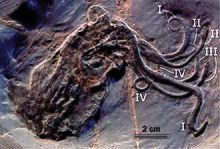| Octopodiformes Temporal range: The oldest fossils of stem-group octopods appeared in the Serpukhovian (late Mississippian)
| |
|---|---|

| |
| Fossil of Proteroctopus from the Middle Jurassic of France, now thought to be a basal vampyropode or vampyromorph | |
| Scientific classification | |
| Domain: | Eukaryota |
| Kingdom: | Animalia |
| Phylum: | Mollusca |
| Class: | Cephalopoda |
| Clade: | Vampyropoda |
| Superorder: | Octopodiformes Fuchs, Von Boletzky, & Tischlinger, 2010[2] |
| Subgroups | |
| Synonyms | |
Octopodiformes is a superorder of the subclass Coleoidea, comprising the octopuses and the vampire squid. All living members of Octopodiformes have eight arms, either lacking the two tentacles of squid (as is the case in octopuses) or modifying the tentacles into thin filaments (as in vampire squid). Octopodiformes is often considered the crown group of octopuses and vampire squids, including all descendants of their common ancestor. Some authors use the term Vampyropoda for the same general category, though others use "Vampyropoda" to refer to the total group (all cephalopods closer to octopods than to true squid). Another term is Octobranchia, referring to cephalopods without prominent tentacles.[4]
It is considered one of the two extant groups of the Neocoleoidea.[2]
Pohlsepia, originally described as earliest octopod is considered as dubious for this group in later study.[1][4] Syllipsimopodi, a squid-like cephalopod from the Mississippian-age Bear Gulch Lagerstätte of Montana, was originally described as the oldest unambiguous vampyropod.[4] However, further analyses might be necessary to unequivocally assign this cephalopod to Vampyropoda.[5][6]
Syllipsimopodi has a combination of squid-like features (like 10 arms) and octopod-like features (like biserial suckers and a simplified internal shell).[4]
- ^ a b Klug, Christian; Landman, Neil H.; Fuchs, Dirk; Mapes, Royal H.; Pohle, Alexander; Guériau, Pierre; Reguer, Solenn; Hoffmann, René (2019-07-31). "Anatomy and evolution of the first Coleoidea in the Carboniferous". Communications Biology. 2 (1): 280. doi:10.1038/s42003-019-0523-2. ISSN 2399-3642. PMC 6668408. PMID 31372519.
- ^ a b Fuchs, D.; Von Boletzky, S.; Tischlinger, H. (2010). "New evidence of functional suckers in belemnoid coleoids (Cephalopoda) weakens support for the 'Neocoleoidea' concept". Journal of Molluscan Studies. 76 (4): 404–406. doi:10.1093/mollus/eyq032.
- ^ a b Cite error: The named reference
tolwebwas invoked but never defined (see the help page). - ^ a b c d Whalen, Christopher D.; Landman, Neil H. (2022-03-08). "Fossil coleoid cephalopod from the Mississippian Bear Gulch Lagerstätte sheds light on early vampyropod evolution". Nature Communications. 13 (1): 1107. Bibcode:2022NatCo..13.1107W. doi:10.1038/s41467-022-28333-5. ISSN 2041-1723. PMC 8904582. PMID 35260548. S2CID 247317831.
- ^ Klug, C.; Stevens, K.; Hoffmann, R.; Zatoń, M.; Clements, T.; Košťák, M.; Weis, R.; De Baets, K.; Lehmann, J.; Vinther, J.; Fuchs, D. (2023). "Revisiting the identification of Syllipsimopodi bideni and timing of the decabrachian-octobrachian divergence". Nature Communications. 14 (1). 8094. doi:10.1038/s41467-023-42842-x. PMC 10703834. PMID 38062003.
- ^ Whalen, C. D.; Landman, N. H. (2023). "Reply to: Revisiting the identification of Syllipsimopodi bideni and timing of the decabrachian-octobrachian divergence". Nature Communications. 14 (1). 8228. doi:10.1038/s41467-023-42843-w. PMC 10716472. PMID 38086818.